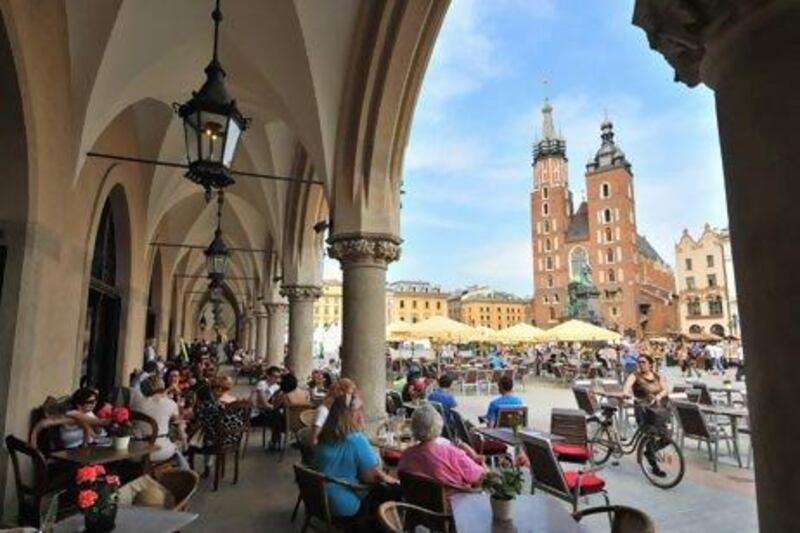Why Krakow?
Poland's cultural capital rivals Prague and Vienna for sheer beauty, architectural richness and a lively nightlife that stays on the right side of raucous. Its entire old town, Stare Miasto, has been designated a Unesco World Heritage Site for its Gothic, baroque and Renaissance landmarks. Unlike other Polish cities, Krakow was spared the destruction by the Nazis during the Second World War, leaving its heart well-preserved.
The main Market Square, Rynek Glowny, is the largest medieval town square in Europe, a vast space where cafe tables invade during the summer months. Its centre is dominated by the Sukennice (Cloth Hall), an ornate Renaissance covered market with a medieval museum hiding underneath. The museum isn't the only subterranean surprise in Krakow: many of its restaurants are housed in historic cellars with vaulted ceilings - very cosy when the weather turns cold.
South of Stare Miasto is Kazimierz, the old Jewish quarter that is experiencing a welcome revival after its near annihilation in the 1940s and neglect during the communist years. Now it's one of Krakow's buzziest districts and full of cafes, bars and restaurants. The city hosts a great number of festivals throughout the year.
A comfortable bed
Many of Krakow's grand townhouses that were left to crumble during the communist years have been transformed into smart hotels. One of them, the friendly four-star Hotel Wentzl (www.wentzl.pl), is the only one on Market Square. Its 18 elegant and spacious rooms hark back to the Habsburg era - apart from the unexpectedly funky ones on the top floor, where modern design runs riot. Doubles with breakfast start at 530 Polish zlotys (Dh613). Poland's only member of the Relais & Chateaux hotel group, the 16th-century Hotel Copernicus (www.copernicus.hotel.com), is a wonderfully romantic spot with a swimming pool and spa built into the ancient cellars. Doubles from 900 zlotys (Dh1,037), excluding breakfast.
Find your feet
Krakow is an easily walkable city, with the most appealing sights within strolling distance of each other. Stare Miasto is the place where most people gather, its historic heart ringed by the green spaces of the Planty. Head directly south down Grodzka, passing one of the main tourist offices (00 48 12 616 18 86; www.krakow.pl; www.poland.travel). Soon you reach Wawel Hill, former seat of Polish royalty and home to stately Wawel Castle and the city's impressive cathedral. Another few minutes south and you reach Kazimierz.
Meet the locals
At least a dozen cafes and restaurants circle Plac Nowy in Kazimerz, where stalls in the market square sell street food such as the pizza-like zapiekanka. Grab a wonky table at Alchemia (www.alchemia.com.pl; 00 48 12 421 22 00) for a friendly drink and live music. In Stare Miasto, squeeze into the cheerfully crowded Nowa Provincja (00 48 12 430 59 59) near Market Square for hot chocolate and cake.
Book a table
Polish food is hearty stuff, with plenty of meat as well as fish from the Baltic Sea. Then there's all the bounty from local forests, ranging from game to pungent mushrooms. Tuck into traditional Polish stews (14 zlotys [Dh16]) and pierogis (potato dumplings; from 16 zlotys [Dh18]) in the splendid Art Nouveau interior of Jama Michalika (Ulica Florianksa 45; www.jamamichalika.pl; 00 48 12 422 15 61), where the Modernists used to meet. Roast duck (48 zlotys [Dh55]) is the speciality of Kogel Mogel (Ulica Sienna 12; www.kogel-mogel.pl; 00 48 12 426 49 68) just off Market Square, where the quirky interior matches the amusing menu satirising the communist newspapers of old.
Shopper's paradise
Krakow is on the ancient amber trading route that runs from St Petersburg to Venice, and Stare Miasto is crammed full of shops selling exquisite amber jewellery at prices far less than in Western Europe (prices are anything from a third to half the price you'll pay in London, for example, and there is much more choice). The stalls in the Cloth Hall are very touristy, but they're such a pretty sight that you don't mind being drawn in - if only for a look. For a large selection of international and local retail outlets, head to the giant Galeria Krakowska shopping mall near the railway station.
What to avoid
Inadvertently tipping too much. In most countries, you say "thank you" when handing over your money when paying the bill. In Krakow, waiters take that to mean "keep the change", which might not be what you intended.
Certain places of interest won't allow you to take photos unless you buy a ticket with permission to do so. It's only a nominal charge, so check for signs at the entrance before you start snapping away.
Don't miss
The museum at the Oskar Schindler factory is utterly captivating, showing what life was like for all of Krakow's residents during the Nazi occupation. While most of the original factory was torn down long ago, the administrative offices behind the white art deco façade seen in Schindler's List have been turned into a highly evocative permanent exhibition.
Go there
Emirates Airline (www.emirates.com) flies direct to Warsaw in five hours, from Dh4,240 return including taxes and to Krakow via Frankfurt and Berlin from Dh4,310 return, including taxes. A train from Warsaw to Krakow takes three hours and costs from 45 zlotys (Dh51) each way.
Follow us
[ @LifeNationalUAE ]
Follow us on Facebook for discussions, entertainment, reviews, wellness and news.





